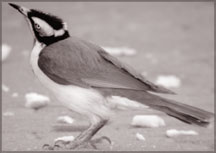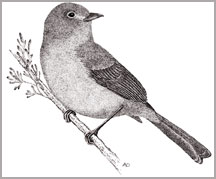Operation Wagtails
The first bird-ringing camp in Sri Lanka:
by K. G. H. Munidasa
Much of the knowledge we have at present about the seasonal migration
of birds we owe to what is called Bird-ringing. It is a process in which
a light metal ring of appropriate size is fastened to the leg of a bird
while on migration or of a young bird before it leaves the nest.
During the ringing particulars as to the bird's specific identity,
the date and place of attaching the ring are recorded in a special
register, and the bird is then released.

The ringing of migrant birds has been going on in the world since
1899, and up to now over 1,000,000 ringed birds has been recovered. In
the British Isles nearly one-hundred thousand birds are annually ringed
and released to further the knowledge on the subject.
In the Americas, it is said, the figure exceeds over 400,000 a year.
In India the Bombay Natural History Society is conducting similar
research on the birds found in that country, during winter migration.
After the discovery of a regular roosting colony of the wagtails in
the Gal Oya Valley, in 1962, the Ceylon Bird Club extended its
bird-ringing program to Sri Lanka, which was formerly done in the Indian
mainland, in collaboration with the BNHS. In the first year 36 Forest
Wagtails were ringed at a sugarcane patch on the right bank of the Gal
Oya River, east of the Ampara town.
The following is a firsthand account of the first ringing camp as
given by the writer, who incidentally discovered the roosting colony and
the person who was instrumental in organising the camp.

In the late 1950s, while I was attached to the Gal Oya Sugar
Industries, watching the flights of wagtails in the evening sky has been
an absorbing pastime of mine. From the varandah of my quarters at
Muwangala I watched them practically everyday at sunset as flock after
flock of these winged creatures passed above me, in an endless stream.
These twittering flocks always came from the setting sun and flew in
an easterly direction, even after the darkness had well advanced. I
never tried to find out why they flew like that or where they were
heading for.
The mysterious flight of the wagtails has been going on for years,
from about each September to April or May, the following year. Then in
February 1963, the Ceylon Bird Club approached me with the peculiar
request, i.e. could I help the club discover a roosting place of the
WAGTAILS, so that its "bird ringing programme could be an extension of
that in India by the Bombay Natural History Society."
The communication added that in India these birds "collected in
enormous flocks there and fly for anything up to 25 miles to certain
small patches of cane, where they arrive at about sunset and leave again
at about sunrise the following morning."
Heeding the request, one evening as the first scattered flocks of
wagtails appeared in the sky, I started to follow them over ground.
Through the maize of sugar cane I tracked them, over wide swamps, across
scrubland, wading streams and deep channels, I followed their aerial
route and finally lost sight of them at dusk, about three miles from my
starting point.
The following evening, I set off from where I had left the previous
day and after another couple of miles run lost them once again in deep
forest, at sunset. On the third day my progress through a stretch of
paddy fields was less cumbersome than the previous evening and coming
out of a wind-belt I spied the cane fields where the roosts were.
A more grandiose sight I had not seen before. The darkening sky was
literally raining birds over an area several acres in extent, and their
twittering became quite a roar in my ears as I approached closer. At a
rough estimate there could have between 40 to 50,000 birds in the
colony.
For the next two weeks I visited the roosts almost daily until the
officials of Ceylon Bird Club arrived at Ampara with nets, collecting
bags and other equipments to begin the ringing operation. As scheduled,
the first ringing camp was held at a place called Galmadu, east of the
Ampara town, on the evening of March 9, 1963.
We reached the location an hour before the first few flocks of birds
arrived in the roosting area, and attended to the initial preparations.
First of all several thin bamboo poles, each 12 feet tall, were planted
along the margin of the standing cane across which the birds were likely
to escape on being flushed.
Then 40-60 ft. nylon Mist nets (so called because their colour
blended amazingly well with the blue-grey sky) were looped on the poles
and pushed up with a stick to a level of one foot above the tops of the
cane.
As the sky darkened, birds started to arrive at the roosts in their
thousands, while we remained under cover until they settled down for the
night. Finally the Operation Wagtails began at 6.30 p.m.
Wearing coarse overalls and gumboots, members of the party crept into
the patch of cane from two sides and progressed through the matted
stems, slowly at first and then making a big commotion as each veered
towards the positioned nets, thus flushing out swarms of birds in the
direction we expected them to fly.
Then began the most tedious job of retrieving the birds from the
nets, where they dangled like a set of strange flies from a giant
cobweb. This called for a certain amount of intelligence and skill, in
order not to cause any damage to wing or feather.
The first harvest brought in 36 Forest Wagtails, with a few munias,
which apparently shared the roosts. The actual ringing commenced in the
mellow light of a paraffin lamp, hung from a nearby branch.
As I said before, the birds to be ringed had to be handled with great
care, compelling one to sit up late into the night.
The light metal ring bearing a serial number and a short message -
(in the present instance it read "INFORM BNHS") , was attached to the
instep region of the bird's leg. Information pertaining to the bird's
specific identity, wing-length, serial number of the ring, date and
location of the ringing camp was recorded on a chart in duplicate (one
copy of which was to be returned to the BNHS), and the bird was then
released.
During the three years the ringing camp was in operation in the Gal
Oya Valley, a little over 300 wagtails were ringed, including a number
of the yellow species, on the final occasion.
No recoveries of ringed birds from Sri Lanka are on record, so far.
Yet a forest wagtail which was picked up dead by a resident of
Hingurana in 1965 and brought to the writer for identification carried a
ring bearing the ser. No. A-60486 and the legend Inform Bombay Natural
History Society. |
